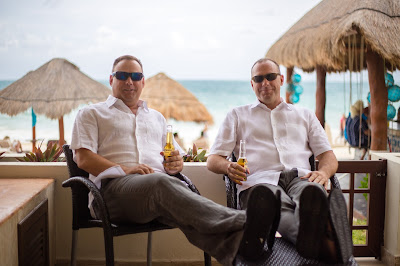My Visit to Auschwitz / Birkenau
 |
| "Work Will Set You Free" - such a lie... :( |
We stepped out of the new and into the old…Foggy mist hung in the air, providing an appropriate melancholy aura to the site. As we approached the infamous gate with its infamous phrase, I swallowed a growing lump in my throat.
So much death and horror had happened here…
Yet, if you ignored the double barbed wire fence around the complex and had no clue about where you stood, it almost passed as an old academic site. The brick building laid out symmetrically, each one connected by a narrow gravel and sand path. Yes, without knowing the past, you could easily never know what had happened within the walls of the buildings.
Which is why the site remains as a reminder. Because that’s how easy it is to forget…
Auschwitz was smaller than I’d expected, and much better to look at. All the buildings were brick, well-kept and in order. But, once inside, you could feel the oppression and heartbreak that had happened. You could feel the pain and suffering as you explored the crude, cold floor with the straw mat (or, in some cases, just plain old straw) strewn on the concrete as beds.
Imagine living like that, with hundreds of other bodies, in the cold, in the dark, in fear.
The prison was set up as a torture chamber. The execution wall sat prominently on display, reinforced for the multiple nonsensical situations for which it was constructed.
Beside the prison, with its cold, dark and sometimes insanely constrictive cells (the small standing-room only one in particular comes to mind), sat another nondescript building in which some of the sterilization experiments happened against women. X-rays were used repeatedly on their abdomens. Women still had to go out and work afterwards. But these were the “lucky” ones who weren’t immediately killed.
Inside the gas chamber, the furnaces sit ominously, reminders of a brutal past. Questions and images run through your mind…and you have no answers and you can’t even begin to fathom the reality that occurred here.
Leaving Auschwitz, I wanted to cry for the souls that were lost. No one around me seemed as affected…it was another tourist stop for them and quickly they were laughing and joking. The constant photography of all that horror seemed unnecessary and perhaps in bad taste…but it can’t, I suppose, be helped when put into such a situation.
Over in Birkenau, we walked up this long path towards another infamous building – the long administration and lookout one with the great arch in it where the train tracks run through…you know what happened on those tracks, and on the tracks leading up to the entry. While Auschwitz seemed small, Birkenau camp stretched on forever…in the fog, the end was invisible.
I’ve read so many books written during the period of WWII that I could visualize quite easily the enormous doom and terror of the trains rolling to a stop beside the dirt platform. See the confusion and fear on the faces of the people who’d been promised “a better life” or the sudden realization of those who already knew the stories about the place.
I could feel the despair in the families that were torn apart and the sudden hopelessness as those that were told to walk towards the end of the platform faced their end in the two smoking crematoriums that had once stood before them.
Camp life was worse here than in Auschwitz. The women’s barracks still stood to be viewed and inside the muddy floors were all they had. The short, wooden “bunks” were building three high and crowded into every single available space. If one person was sick, everyone else would almost certainly end up sick too. There was no escape…
To be deemed a lesser human and treated worse than any animal I’ve ever encountered (and these people were treated way worse than animals, at least the farm animals I grew up with, who lived in a similar way, sleeping on straw and crowded into shelters in the winter…at least the farm animals got enough food to eat and, later on, were spoiled with heated barns when they needed them), it’s unfathomable what exactly these people experienced.
Overall, it’s just excruciatingly sad and incomprehensible. Over 1.1 million people were known to have died between the 3 camps called Auschwitz…yet estimates consider this only 1/3 of the truth.
As cowards will do in the face of discovery, the Nazis tried in desperation to destroy as much evidence of their crimes as possible. The crematoriums were blown up, documents were burned and they fled. Statistically, only 10% of the entire fleet of Nazi war criminals were ever prosecuted and properly punished. The rest were pardoned or simply got away.
The survivors of the camps were never the same but you have to be so grateful for the ones that were still strong enough to come forward afterwards and say “don’t destroy these places…let them stand and be reminders”. And thank the ones who willingly risked their lives by documenting what happened and securing that evidence around the camps…to be found years and decades later during searches and restoration activities. If it weren’t for them, evidence may never exist and this could happen again.
I will always feel heart break and cry openly on the bus while reading about the stories set in that time…and will always now be grateful for taking the time to visit and learn much more about that camp and the other atrocities of the war.








Comments
Post a Comment